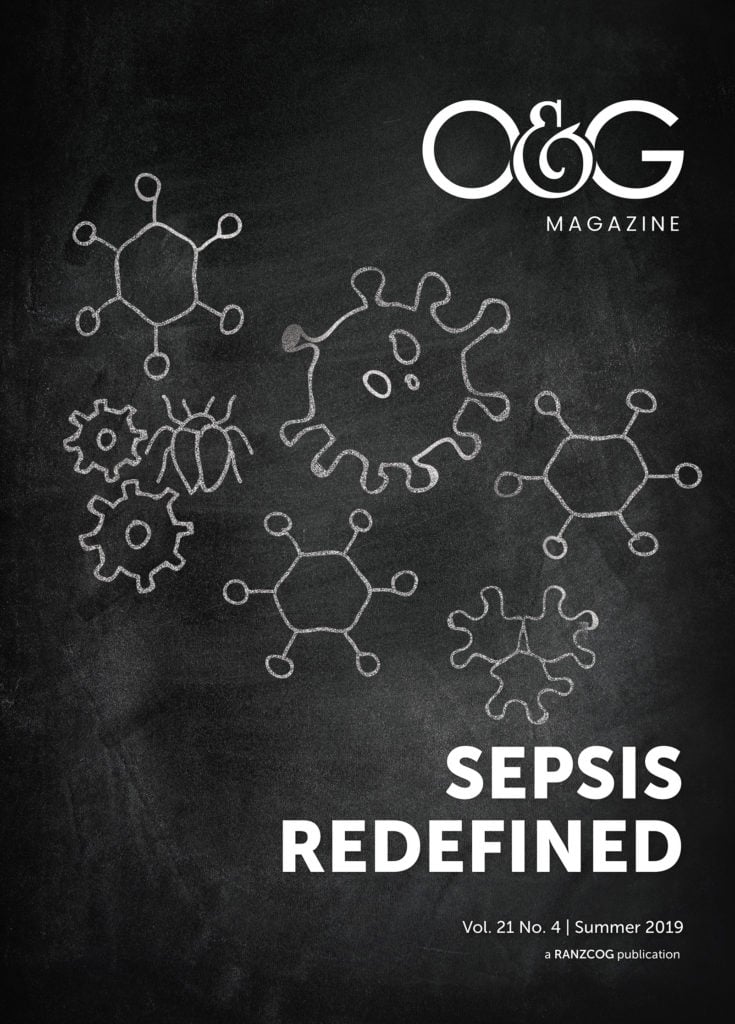Sepsis is a leading cause of maternal death worldwide and occurs most commonly in the puerperium.1 Maternal mortality due to sepsis has declined in Australia, but is still a leading cause of maternal death with a maternal mortality ratio of 0.6 per 100 000 women giving birth from 2006–16.2
Sepsis is broadly defined as life-threatening organ dysfunction caused by a dysregulated host response to infection. Septic shock is the subset of sepsis in which profound circulatory, cellular and metabolic abnormalities substantially increase mortality. It is characterised by significant hypotension requiring vasopressors to maintain mean arterial pressure (MAP) of 65 mm Hg or higher and serum lactate of 2 mmol/L or higher, despite adequate fluid resuscitation.3
Identifying postnatal patients in the early stages of sepsis who are at risk of progressing to septic shock can ensure timely initiation of vital treatments to prevent progression to irreversible organ dysfunction, disseminated intravascular coagulation and death.
Initial assessment
History and examination should be directed towards identification of the likely source of infection in the postnatal patient.4 5 Sepsis most commonly arises from the genital tract, with endometritis being the most common source of infection and caesarean section being the single most important risk factor for postnatal sepsis.6 7 8 Prophylactic intravenous antibiotics 15–60 minutes prior to skin incision at caesarean section greatly reduces infection, but does not eliminate it.9 10 Multiple vaginal examinations, genital tract trauma and instrumental delivery are additional intrapartum risk factors for postnatal sepsis. Other genital tract sources of sepsis include pelvic inflammatory disease, tubo-ovarian abscess and retained products of conception.11
Maternal risk factors for sepsis should also be elicited. Medical comorbidities, particularly anaemia and immunosuppression, were found to be the most important factors driving the association between severe sepsis and death in one study.12
In addition to assessment of risk factors (Table 1) a complete medical, obstetric and infectious disease history should be undertaken. Common non-specific symptoms of sepsis in the postnate include fever, diarrhoea, vomiting, vaginal discharge and abdominal pain. Rigours or severe myalgia (especially anterior thigh) can herald severe bacterial infection and should prompt concern in the treating team. Agonising pain out of proportion to clinical signs should prompt consideration of necrotising fasciitis/myositis. A generalised maculopapular rash, especially in combination with conjunctival hyperaemia or suffusion may be an early sign of toxic shock syndrome due to staphylococcal or streptococcal infection. Increasing vaginal bleeding or a history of offensive lochia may suggest endometritis or retained products of conception. However, some infections, particularly Group A Streptococcus (GAS) frequently present with scant, odourless lochia. GAS may also present with other non-specific symptoms including fever, sore throat, vomiting, severe abdominal pain and diarrhoea. Suspected GAS sepsis should be managed aggressively due to its invasive nature and association with a higher maternal mortality rate than other organisms.13 14 Postpartum women have a 20-fold increase in the incidence of invasive GAS and Group B Streptococcus infection compared to non-pregnant women.15
Table 1. Risk factors for sepsis in the postnatal patient.16 17 18
Maternal risk factors |
Pregnancy-related risk factors |
| Medical comorbidities (such as anaemia, immunosuppression, diabetes, obesity) | Caesarean section |
| Nutritional status | Instrumental delivery |
| History of pelvic infection and vaginal discharge, including bacterial vaginosis | Premature or prolonged rupture of membranes |
| Minority ethnic group, including Aboriginal and Torres Strait Islanders | Frequent cervical examinations |
| GAS infection in family members and close contacts | Internal fetal monitoring |
| Amniocentesis, cervical cerclage and other invasive procedures | |
| Vaginal and perineal trauma | |
| Vaginal haematoma |
Sources extraneous to the genital tract should also be considered: mastitis, breast abscess, urinary tract infection, respiratory tract infection (including pneumonia and influenza), soft tissue and skin infection (including surgical site infection and necrotising fasciitis), gastroenteritis, pharyngitis, infection related to regional anaesthesia and intravenous cannulation are common sources of sepsis in postnatal patients. Less common causes include bacterial meningitis, septic pulmonary embolus, deep vein thrombosis, septic pelvic phlebitis and appendicitis.
Non-infective causes that may mimic sepsis, including acute pulmonary embolism, autoimmune conditions and acute liver failure, should also be considered.19
Investigations
Preliminary investigations will be guided by suspected sources of sepsis. Blood cultures are the key investigation; ideally at least two (and, if possible, three) sets should be obtained from separate sites prior to antibiotic administration.20 Collection of blood cultures prior to antibiotic administration greatly increases the sensitivity of identifying the causative organism and directing antibiotic therapy. Investigations should not unduly delay antibiotic administration when bacterial sepsis is suspected, as antibiotic administration within the first ‘golden’ hour is crucial for maternal survival. Mortality increases by 8 per cent for each hours’ delay in antibiotic administration.21 22
Other microbial samples should be guided by clinical suspicion for the focus of infection and may include: throat, nasopharygenal aspirate, high vaginal, placental, epidural site, caesarean or episiotomy swabs; and/or breast milk, urine, stool, cerebrospinal fluid and sputum samples. The laboratory should be informed where there is clinical suspicion of unusual pathogens such as Listeria monocytogenes, typhoid, fungal species or tuberculosis, and expert opinion from a microbiologist sought if there is any uncertainty in tests to be ordered or specimens to be collected.23
Routine blood tests should be performed urgently and include: FBC, CRP, UEC, LFT, coagulation studies (or ROTEM) and lactate. An arterial blood gas provides further information regarding acidosis and hypoxia.24 25 26
Imaging should occur promptly and be guided by the clinical picture. Imaging should not be withheld due to breastfeeding and may include chest x-ray, pelvic ultrasound and CT scan.27 28 29
Management
Early recognition of sepsis and assessment of severity are essential to initiating appropriate and timely management. Postnatal sepsis may have an insidious onset but fulminant course.30 Of note, fever has not been included in the current diagnostic criteria for sepsis.31 The Sequential (sepsis-related) Organ Failure Assessment (SOFA) score has been validated to identify patients with a high risk of in-hospital mortality,32 but is impractical to use at the bedside. Thus, the quick SOFA (qSOFA) can be used to screen for sepsis.33
A qSOFA score of 2 or more identifies patients with a high risk of in-hospital mortality.34 Patients suspected of having sepsis based on screening should be assessed for end organ dysfunction as evidenced by a change in the SOFA score of 2 or more.35 Due to the physiological changes associated with pregnancy, an obstetrically modified qSOFA (omqSOFA) and SOFA (omSOFA) have been developed.36 These should be used during pregnancy and for one week postpartum, after which time qSOFA and SOFA should be used, as maternal physiology gradually returns to normal.37 Of note, the maternal blood pressure often peaks 48 hours post birth, and can be higher than values obtained six months postpartum, which should be kept in mind when assessing postnates for sepsis.38 39 Once sepsis is diagnosed, it should trigger a coordinated multidisciplinary team approach and discussion with critical care providers.40
Antimicrobial therapy
Timely initiation of intravenous antimicrobial therapy is important for maternal survival. Antimicrobial choice should be based on likely source of sepsis and local guidelines. Where no source is apparent, antibiotics for postpartum endometritis should be initiated (gentamicin, metronidazole, amoxicillin OR ampicillin, in this order) given endometritis is the most likely source.41 Gentamicin should be given first as it is the most effective agent for Gram-negative bacteraemia with the quickest onset of action. Alternatively, if endometritis is considered highly unlikely, empirical antibiotics for sepsis of unknown origin can be considered. If GAS is suspected, consider the addition of clindamycin to switch off exotoxin production, which reduces mortality. Flucloxacillin should be used for wound infections and mastitis.42 Vancomycin should be considered if MRSA is suspected.5 Box 1 outlines common pathogens implicated in postnatal sepsis, remembering that genital tract related sepsis is often polymicrobial.43 Nuraminidase inhibitors, oseltamivir or zanamivir, should be given if influenza is suspected.44
Some infections, including GAS and S. Aureus, require prophylaxis for the neonate (and household contacts) as transmission can occur, including during breastfeeding. The treating team should alert neonatologists and infectious disease physicians to the presence of maternal infection.45
Most antibiotics are transferred into breast milk; however, the dose to the infant is relatively small. Infants should be monitored for antimicrobial-associated side effects, including vomiting, diarrhoea, thrush or skin rash. Antibiotic therapy should be de-escalated and ceased as soon as practicable to help maintain normal gut microbiota in the infant and mother.46
- Group A-beta-haemolytic Streptococcus pyogenes (GAS) – commonest cause of maternal death due to sepsis49 50
- Escherichia coli – commonest cause of maternal bacterial infection51 52
- Staphylococcus aureus, including methicillin resistant S. aureus (MRSA) – commonest cause of mastitis and surgical site infection53
- Streptococcus pneumoniae
- Clostridium spp
- Morganella morganii
- Anaerobic infections – Bacteroides sp, Prevotella sp, Prophyromonas sp, Preptostreptococcus sp and Finegolida sp
Source control
The focus of infection should be treated. Evacuation of retained products of conception, surgical debridement of wounds, evacuation of infected haematomas, incision and drainage of breast or pelvic collections may be required to achieve source control. Samples should be taken for microscopy, culture, stain or nucleic acid amplification testing. Further antibiotics may be required to cover procedures.54 55
Fluid resuscitation and supportive care
Fluid resuscitation for hypotension and tissue hypoperfusion should be initiated with an isotonic crystalloid (usually normal saline 0.9%)56 57 at 20 mL/kg, to a maximum of 2 L in the ward setting.58 An indwelling catheter should be inserted, and strict fluid balance recorded. Postpartum women may be more susceptible to fluid overload and pulmonary oedema than non-pregnant patients, which can make fluid resuscitation exceedingly difficult. Vasopressors are generally indicated if MAP above 65 mm Hg cannot be maintained or serum lactates continue to rise. Central venous pressure monitoring may be required. Thus, it is important to involve critical care teams, anaesthetists and intensive care physicians early, especially if transfer to another healthcare facility, with an ICU, is required.
Supplemental oxygen may be required if saturations are abnormal.59
Intravenous immunoglobulin can be considered in invasive streptococcal or staphylococcal infection, as it neutralises super antigen effects of exotoxins and inhibits production of inflammatory cytokines.60 61
Nonsteroidal anti-inflammatory drugs should be avoided in GAS sepsis, as they inhibit polymorphs.62
Thromboembolism prophylaxis should be initiated, as sepsis and the pureperium are both independent risk factors for venous thromboembolism.63 64
Conclusion
Prompt recognition and treatment with appropriate antibiotic therapy and source control are essential to minimise maternal morbidity, and potentially death, in septic postnates. Optimal patient outcomes further rely on a multidisciplinary team approach that can deliver effective supportive therapy and escalate care in the deteriorating patient.
References
- Knowles SJ, O’Sullivan NP, Meenan AM, et al. Maternal sepsis incidence, aetiology and outcome for the mother and fetus: a prospective study. BJOG. 2015;122:633-71.
- Australian Institute of Health and Welfare. Maternal deaths in Australia 2016. Canberra: Australian Institute of Health and Welfare, 2018. Available from: www.aihw.gov.au/reports/mothers-babies/maternal-deaths-in-australia-2016.
- Singer M, Deutschman CS, Seymour CW, et al. The Third International Consensus Definitions for Sepsis and Septic Shock (Sepsis-3). JAMA. 2016;315(8):801-10.
- Morgan M, Hughes RG, Kinsella SM on behalf of the Royal College of Obstetricians and Gynaecologists. Bacterial sepsis following pregnancy. Green-top Guideline No. 64b. 2012. Available from: www.rcog.org.uk/en/guidelines-research-services/guidelines/gtg64b/.
- Bowyer L, Robinson H, Barrett H, et al. SOMANZ Guidelines for the investigation ad management of sepsis in pregnancy. 2017. Society of Obstetric Medicine Australia and New Zealand. Available from: www.somanz.org/downloads/2017SepsisGuidelines.pdf.
- Morgan M, Hughes RG, Kinsella SM on behalf of the Royal College of Obstetricians and Gynaecologists. Bacterial sepsis following pregnancy. Green-top Guideline No. 64b. 2012. Available from: www.rcog.org.uk/en/guidelines-research-services/guidelines/gtg64b/.
- Mohamed-Ahmed O, Nair M, Acosta C, et al. Progression from severe sepsis in pregnancy to death: a UK population-based case-control analysis. BJOG. 2015;122:1506–15.
- Kakuri E, Kurki T, Carlson P, Hilsemaa V. Incidence, treatment and outcome of peripartum sepsis. Acta Obstet Gynecol Scand. 2003;82:730-35.
- Dahlke JD, Mendez-Figueroa H, Rouse DJ, et al. Evidence based surgery for caesarean delivery: an updated systematic review. Am J Obstet Gynecol. 2013;209:294-306.
- Mackeen A, Packard RE, Ota E, et al. Timing of intravenous prophylactic antibiotics for preventing postpartum infectious morbidity in women undergoing cesarean delivery. Cochrane Database Syst Rev. 2014;12:CD009516.
- King Edward Memorial Hospital Clinical Guidelines. Postpartum infections: treatment and management. 2017. Available from: www.kemh.health.wa.gov.au/~/media/Files/Hospitals/WNHS/For%20health%20professionals/Clinical%20guidelines/OG/WNHS.OG.InfectionPostnatalInfectionTreatment.pdf.
- Mohamed-Ahmed O, Nair M, Acosta C, et al. Progression from severe sepsis in pregnancy to death: a UK population-based case-control analysis. BJOG. 2015;122:1506–15.
- Morgan M, Hughes RG, Kinsella SM on behalf of the Royal College of Obstetricians and Gynaecologists. Bacterial sepsis following pregnancy. Green-top Guideline No. 64b. 2012. Available from: www.rcog.org.uk/en/guidelines-research-services/guidelines/gtg64b/.
- Bowyer L, Robinson H, Barrett H, et al. SOMANZ Guidelines for the investigation ad management of sepsis in pregnancy. 2017. Society of Obstetric Medicine Australia and New Zealand. Available from: www.somanz.org/downloads/2017SepsisGuidelines.pdf.
- Deutscher M, Lewis M, Zell ER, et al. Incidence and Severity of Invasive Streptococcus pneumoniae, Group A Streptococcus, and Group B Streptococcus Infections Among Pregnant and Postpartum Women. Clinical Infectious Diseases. 2011;53(2):114-23.
- Morgan M, Hughes RG, Kinsella SM on behalf of the Royal College of Obstetricians and Gynaecologists. Bacterial sepsis following pregnancy. Green-top Guideline No. 64b. 2012. Available from: www.rcog.org.uk/en/guidelines-research-services/guidelines/gtg64b/.
- Mohamed-Ahmed O, Nair M, Acosta C, et al. Progression from severe sepsis in pregnancy to death: a UK population-based case-control analysis. BJOG. 2015;122:1506–15.
- King Edward Memorial Hospital Clinical Guidelines. Postpartum infections: treatment and management. 2017. Available from: www.kemh.health.wa.gov.au/~/media/Files/Hospitals/WNHS/For%20health%20professionals/Clinical%20guidelines/OG/WNHS.OG.InfectionPostnatalInfectionTreatment.pdf.
- Bowyer L, Robinson H, Barrett H, et al. SOMANZ Guidelines for the investigation ad management of sepsis in pregnancy. 2017. Society of Obstetric Medicine Australia and New Zealand. Available from: www.somanz.org/downloads/2017SepsisGuidelines.pdf.
- Morgan M, Hughes RG, Kinsella SM on behalf of the Royal College of Obstetricians and Gynaecologists. Bacterial sepsis following pregnancy. Green-top Guideline No. 64b. 2012. Available from: www.rcog.org.uk/en/guidelines-research-services/guidelines/gtg64b/.
- Bowyer L, Robinson H, Barrett H, et al. SOMANZ Guidelines for the investigation ad management of sepsis in pregnancy. 2017. Society of Obstetric Medicine Australia and New Zealand. Available from: www.somanz.org/downloads/2017SepsisGuidelines.pdf.
- Kumar A, Roberts D, Wood KE, et al. Duration of hypotension before initiation of effective antimicrobial therapy is the critical determinant of survival in human septic shock. Critical Care Medicine. 2006;34(6):1589-96.
- Morgan M, Hughes RG, Kinsella SM on behalf of the Royal College of Obstetricians and Gynaecologists. Bacterial sepsis following pregnancy. Green-top Guideline No. 64b. 2012. Available from: www.rcog.org.uk/en/guidelines-research-services/guidelines/gtg64b/.
- Morgan M, Hughes RG, Kinsella SM on behalf of the Royal College of Obstetricians and Gynaecologists. Bacterial sepsis following pregnancy. Green-top Guideline No. 64b. 2012. Available from: www.rcog.org.uk/en/guidelines-research-services/guidelines/gtg64b/.
- Bowyer L, Robinson H, Barrett H, et al. SOMANZ Guidelines for the investigation ad management of sepsis in pregnancy. 2017. Society of Obstetric Medicine Australia and New Zealand. Available from: www.somanz.org/downloads/2017SepsisGuidelines.pdf.
- King Edward Memorial Hospital Clinical Guidelines. Postpartum infections: treatment and management. 2017. Available from: www.kemh.health.wa.gov.au/~/media/Files/Hospitals/WNHS/For%20health%20professionals/Clinical%20guidelines/OG/WNHS.OG.InfectionPostnatalInfectionTreatment.pdf.
- Morgan M, Hughes RG, Kinsella SM on behalf of the Royal College of Obstetricians and Gynaecologists. Bacterial sepsis following pregnancy. Green-top Guideline No. 64b. 2012. Available from: www.rcog.org.uk/en/guidelines-research-services/guidelines/gtg64b/.
- Bowyer L, Robinson H, Barrett H, et al. SOMANZ Guidelines for the investigation ad management of sepsis in pregnancy. 2017. Society of Obstetric Medicine Australia and New Zealand. Available from: www.somanz.org/downloads/2017SepsisGuidelines.pdf.
- King Edward Memorial Hospital Clinical Guidelines. Postpartum infections: treatment and management. 2017. Available from: www.kemh.health.wa.gov.au/~/media/Files/Hospitals/WNHS/For%20health%20professionals/Clinical%20guidelines/OG/WNHS.OG.InfectionPostnatalInfectionTreatment.pdf.
- Morgan M, Hughes RG, Kinsella SM on behalf of the Royal College of Obstetricians and Gynaecologists. Bacterial sepsis following pregnancy. Green-top Guideline No. 64b. 2012. Available from: www.rcog.org.uk/en/guidelines-research-services/guidelines/gtg64b/.
- Bowyer L, Robinson H, Barrett H, et al. SOMANZ Guidelines for the investigation ad management of sepsis in pregnancy. 2017. Society of Obstetric Medicine Australia and New Zealand. Available from: www.somanz.org/downloads/2017SepsisGuidelines.pdf.
- Singer M, Deutschman CS, Seymour CW, et al. The Third International Consensus Definitions for Sepsis and Septic Shock (Sepsis-3). JAMA. 2016;315(8):801-10.
- Seymour CW, Liu VX, Iwashyna TJ, et al. Assessment of Clinical Criteria for Sepsis: For the Third International Consensus Definitions for Sepsis and Septic Shock (Sepsis-3). JAMA. 2016;315(8):762-74.
- Seymour CW, Liu VX, Iwashyna TJ, et al. Assessment of Clinical Criteria for Sepsis: For the Third International Consensus Definitions for Sepsis and Septic Shock (Sepsis-3). JAMA. 2016;315(8):762-74.
- Singer M, Deutschman CS, Seymour CW, et al. The Third International Consensus Definitions for Sepsis and Septic Shock (Sepsis-3). JAMA. 2016;315(8):801-10.
- Bowyer L, Robinson H, Barrett H, et al. SOMANZ Guidelines for the investigation ad management of sepsis in pregnancy. 2017. Society of Obstetric Medicine Australia and New Zealand. Available from: www.somanz.org/downloads/2017SepsisGuidelines.pdf.
- Bowyer L, Robinson H, Barrett H, et al. SOMANZ Guidelines for the investigation ad management of sepsis in pregnancy. 2017. Society of Obstetric Medicine Australia and New Zealand. Available from: www.somanz.org/downloads/2017SepsisGuidelines.pdf.
- Bowyer L, Robinson H, Barrett H, et al. SOMANZ Guidelines for the investigation ad management of sepsis in pregnancy. 2017. Society of Obstetric Medicine Australia and New Zealand. Available from: www.somanz.org/downloads/2017SepsisGuidelines.pdf.
- San-Frutos L, Engels V, Zapardiel I, et al. Haemodynamic changes during pregnancy and postpartum; a prospective study using thoracic electrical bioimpedance. J Matern Fetal Neonatal Med. 2011;24:1333-40.
- Morgan M, Hughes RG, Kinsella SM on behalf of the Royal College of Obstetricians and Gynaecologists. Bacterial sepsis following pregnancy. Green-top Guideline No. 64b. 2012. Available from: www.rcog.org.uk/en/guidelines-research-services/guidelines/gtg64b/.
- Bowyer L, Robinson H, Barrett H, et al. SOMANZ Guidelines for the investigation ad management of sepsis in pregnancy. 2017. Society of Obstetric Medicine Australia and New Zealand. Available from: www.somanz.org/downloads/2017SepsisGuidelines.pdf.
- Bowyer L, Robinson H, Barrett H, et al. SOMANZ Guidelines for the investigation ad management of sepsis in pregnancy. 2017. Society of Obstetric Medicine Australia and New Zealand. Available from: www.somanz.org/downloads/2017SepsisGuidelines.pdf.
- King Edward Memorial Hospital Clinical Guidelines. Postpartum infections: treatment and management. 2017. Available from: www.kemh.health.wa.gov.au/~/media/Files/Hospitals/WNHS/For%20health%20professionals/Clinical%20guidelines/OG/WNHS.OG.InfectionPostnatalInfectionTreatment.pdf.
- Bowyer L, Robinson H, Barrett H, et al. SOMANZ Guidelines for the investigation ad management of sepsis in pregnancy. 2017. Society of Obstetric Medicine Australia and New Zealand. Available from: www.somanz.org/downloads/2017SepsisGuidelines.pdf.
- Morgan M, Hughes RG, Kinsella SM on behalf of the Royal College of Obstetricians and Gynaecologists. Bacterial sepsis following pregnancy. Green-top Guideline No. 64b. 2012. Available from: www.rcog.org.uk/en/guidelines-research-services/guidelines/gtg64b/.
- Bowyer L, Robinson H, Barrett H, et al. SOMANZ Guidelines for the investigation ad management of sepsis in pregnancy. 2017. Society of Obstetric Medicine Australia and New Zealand. Available from: www.somanz.org/downloads/2017SepsisGuidelines.pdf.
- Morgan M, Hughes RG, Kinsella SM on behalf of the Royal College of Obstetricians and Gynaecologists. Bacterial sepsis following pregnancy. Green-top Guideline No. 64b. 2012. Available from: www.rcog.org.uk/en/guidelines-research-services/guidelines/gtg64b/.
- King Edward Memorial Hospital Clinical Guidelines. Postpartum infections: treatment and management. 2017. Available from: www.kemh.health.wa.gov.au/~/media/Files/Hospitals/WNHS/For%20health%20professionals/Clinical%20guidelines/OG/WNHS.OG.InfectionPostnatalInfectionTreatment.pdf.
- Morgan M, Hughes RG, Kinsella SM on behalf of the Royal College of Obstetricians and Gynaecologists. Bacterial sepsis following pregnancy. Green-top Guideline No. 64b. 2012. Available from: www.rcog.org.uk/en/guidelines-research-services/guidelines/gtg64b/.
- Bowyer L, Robinson H, Barrett H, et al. SOMANZ Guidelines for the investigation ad management of sepsis in pregnancy. 2017. Society of Obstetric Medicine Australia and New Zealand. Available from: www.somanz.org/downloads/2017SepsisGuidelines.pdf.
- Morgan M, Hughes RG, Kinsella SM on behalf of the Royal College of Obstetricians and Gynaecologists. Bacterial sepsis following pregnancy. Green-top Guideline No. 64b. 2012. Available from: www.rcog.org.uk/en/guidelines-research-services/guidelines/gtg64b/.
- Bowyer L, Robinson H, Barrett H, et al. SOMANZ Guidelines for the investigation ad management of sepsis in pregnancy. 2017. Society of Obstetric Medicine Australia and New Zealand. Available from: www.somanz.org/downloads/2017SepsisGuidelines.pdf.
- Knowles SJ, O’Sullivan NP, Meenan AM, et al. Maternal sepsis incidence, aetiology and outcome for the mother and fetus: a prospective study. BJOG. 2015;122:633-71.
- Morgan M, Hughes RG, Kinsella SM on behalf of the Royal College of Obstetricians and Gynaecologists. Bacterial sepsis following pregnancy. Green-top Guideline No. 64b. 2012. Available from: www.rcog.org.uk/en/guidelines-research-services/guidelines/gtg64b/.
- Bowyer L, Robinson H, Barrett H, et al. SOMANZ Guidelines for the investigation ad management of sepsis in pregnancy. 2017. Society of Obstetric Medicine Australia and New Zealand. Available from: www.somanz.org/downloads/2017SepsisGuidelines.pdf.
- Singer M, Deutschman CS, Seymour CW, et al. The Third International Consensus Definitions for Sepsis and Septic Shock (Sepsis-3). JAMA. 2016;315(8):801-10.
- Morgan M, Hughes RG, Kinsella SM on behalf of the Royal College of Obstetricians and Gynaecologists. Bacterial sepsis following pregnancy. Green-top Guideline No. 64b. 2012. Available from: www.rcog.org.uk/en/guidelines-research-services/guidelines/gtg64b/.
- Bowyer L, Robinson H, Barrett H, et al. SOMANZ Guidelines for the investigation ad management of sepsis in pregnancy. 2017. Society of Obstetric Medicine Australia and New Zealand. Available from: www.somanz.org/downloads/2017SepsisGuidelines.pdf.
- Bowyer L, Robinson H, Barrett H, et al. SOMANZ Guidelines for the investigation ad management of sepsis in pregnancy. 2017. Society of Obstetric Medicine Australia and New Zealand. Available from: www.somanz.org/downloads/2017SepsisGuidelines.pdf.
- Morgan M, Hughes RG, Kinsella SM on behalf of the Royal College of Obstetricians and Gynaecologists. Bacterial sepsis following pregnancy. Green-top Guideline No. 64b. 2012. Available from: www.rcog.org.uk/en/guidelines-research-services/guidelines/gtg64b/.
- McLintock C, Brighton T, Chunilal S, et al. Recommendations for the prevention of pregnancy-associated venous thromboembolism. ANZJOG. 2012;52(1):3-13.
- Morgan M, Hughes RG, Kinsella SM on behalf of the Royal College of Obstetricians and Gynaecologists. Bacterial sepsis following pregnancy. Green-top Guideline No. 64b. 2012. Available from: www.rcog.org.uk/en/guidelines-research-services/guidelines/gtg64b/.
- Bowyer L, Robinson H, Barrett H, et al. SOMANZ Guidelines for the investigation ad management of sepsis in pregnancy. 2017. Society of Obstetric Medicine Australia and New Zealand. Available from: www.somanz.org/downloads/2017SepsisGuidelines.pdf.
- McLintock C, Brighton T, Chunilal S, et al. Recommendations for the prevention of pregnancy-associated venous thromboembolism. ANZJOG. 2012;52(1):3-13.








Leave a Reply